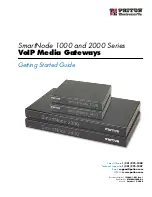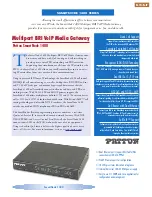
Version 6.6
419
Mediant 3000
User's Manual
28. SBC Overview
28.5 Fax Negotiation and Transcoding
The device can allow fax transmissions to traverse transparently without transcoding or it
can handle the fax as follows:
Allow interoperability between different fax machines, supporting fax transcoding if
required.
Restrict usage of specific fax coders to save bandwidth, enhance performance, or
comply with supported coders. These coders include G.711 (A-Law or Mu-Law), VBD
(G.711 A-Law or G.711 Mu-Law), and T38.
Fax configuration is done in the IP Profile and Coder Group Settings tables. The IP Profile
table determines the supported fax coders and the negotiation method used between the
incoming and outgoing fax legs, using the following fax-related parameters:
SBCFaxBehavior: defines the offer negotiation method - pass fax transparently,
negotiate fax according to fax settings in IP Profile, or enforce remote UA to first
establish a voice channel before fax negotiation.
SBCFaxCodersGroupID: defines the supported fax coders (from the Coders Group
Settings table).
SBCFaxOfferMode: determines the fax coders sent in the outgoing SDP offer.
SBCFaxAnswerMode: determines the fax coders sent in the outgoing SDP answer.
Note:
The voice-related coder configuration (Allowed and Extended coders) is
independent of the fax-related coder configuration, with the exception of the
G.711 coder. If the G.711 coder is restricted by the Allowed Coders Group
table, it is not used for fax processing even if it is listed in the Coders Group
Settings table for faxes. However, support for G.711 coders for voice is not
dependent upon which fax coders are listed in the Coders Group Settings
table.
28.6 Limiting SBC Call Duration
You can define a maximum allowed duration (in minutes) for SBC calls. If an established
call reaches this user-defined limit, the device terminates the call. This feature ensures
calls are properly terminated, allowing available resources for new calls. This feature is
configured using the MaxCallDuration parameter.
28.7 SIP Authentication Server for SBC Users
The device can function as an authentication server for SIP SBC message requests, based
on HTTP authentication DIGEST with MD5. Alternatively, such requests can be
authenticated by an external, third-party server.
When functioning as an authentication server (set by the IP Group table parameter,
AuthenticationMode), the device authenticates users belonging to a User-type IP Group.
When the device receives an INVITE or REGISTER request from a client (e.g., SIP phone)
for SIP message authorization, the device processes the authorization as follows:
1.
The device verifies the type of incoming SIP method (e.g., INVITE) that must be
challenged for authorization. This is configured using the IP Group table parameter,
MethodList.
2.
If the message is received without an Authorization header, the device "challenges"
the client by sending a 401 or 407 SIP response. The client then resends the request
Summary of Contents for Mediant 3000
Page 2: ......
Page 26: ...User s Manual 26 Document LTRT 89729 Mediant 3000 Reader s Note...
Page 27: ...Part I Getting Started with Initial Connectivity...
Page 28: ......
Page 40: ...User s Manual 40 Document LTRT 89729 Mediant 3000 Reader s Notes...
Page 41: ...Part II Management Tools...
Page 42: ......
Page 44: ...User s Manual 44 Document LTRT 89729 Mediant 3000 Reader s Notes...
Page 80: ...User s Manual 80 Document LTRT 89729 Mediant 3000 Reader s Notes...
Page 98: ...User s Manual 98 Document LTRT 89729 Mediant 3000 Reader s Notes...
Page 103: ...Part III General System Settings...
Page 104: ......
Page 113: ...Part IV General VoIP Configuration...
Page 114: ......
Page 144: ...User s Manual 144 Document LTRT 89729 Mediant 3000 Reader s Notes...
Page 164: ...User s Manual 164 Document LTRT 89729 Mediant 3000 Reader s Notes...
Page 222: ...User s Manual 222 Document LTRT 89729 Mediant 3000 Reader s Notes...
Page 224: ...User s Manual 224 Document LTRT 89729 Mediant 3000 Reader s Notes...
Page 275: ...Part V Gateway and IP to IP Application...
Page 276: ......
Page 278: ...User s Manual 278 Document LTRT 89729 Mediant 3000 Reader s Notes...
Page 399: ...Part VI Session Border Controller Application...
Page 400: ......
Page 402: ...User s Manual 402 Document LTRT 89729 Mediant 3000 Reader s Notes...
Page 464: ...User s Manual 464 Document LTRT 89729 Mediant 3000 Reader s Notes...
Page 465: ...Part VII Stand Alone Survivability Application...
Page 466: ......
Page 474: ...User s Manual 474 Document LTRT 89729 Mediant 3000 Reader s Notes...
Page 494: ...User s Manual 494 Document LTRT 89729 Mediant 3000 Reader s Notes...
Page 497: ...Part VIII IP Media Capabilities...
Page 498: ......
Page 501: ...Part IX High Availability System...
Page 502: ......
Page 515: ...Part X Maintenance...
Page 516: ......
Page 522: ...User s Manual 522 Document LTRT 89729 Mediant 3000 Reader s Notes...
Page 524: ...User s Manual 524 Document LTRT 89729 Mediant 3000 Reader s Notes...
Page 552: ...User s Manual 552 Document LTRT 89729 Mediant 3000 Reader s Notes...
Page 562: ...User s Manual 562 Document LTRT 89729 Mediant 3000 Reader s Notes...
Page 565: ...Part XI Status Performance Monitoring and Reporting...
Page 566: ......
Page 578: ...User s Manual 578 Document LTRT 89729 Mediant 3000 Reader s Notes...
Page 609: ...Part XII Diagnostics...
Page 610: ......
Page 624: ...User s Manual 624 Document LTRT 89729 Mediant 3000 Reader s Notes...
Page 626: ...User s Manual 626 Document LTRT 89729 Mediant 3000 Reader s Notes...
Page 638: ...User s Manual 638 Document LTRT 89729 Mediant 3000 Reader s Notes...
Page 639: ...Part XIII Appendix...
Page 640: ......
Page 864: ...User s Manual 864 Document LTRT 89729 Mediant 3000 Reader s Notes...
Page 871: ...Version 6 6 871 Mediant 3000 User s Manual 55 Selected Technical Specifications Reader s Notes...
















































